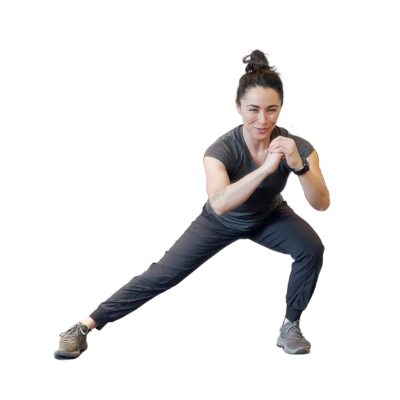Exercise Tutorial: Lateral Lunge
Table of Contents
What Is a Lateral Lunge
The Lateral lunge (also known as a Side Lunge) is a bilateral bodyweight exercise that targets your glutes, quads, and inner and outer thighs to build your lower body strength and tone your legs.
The Lateral Lunge is also a great variation to the conventional Forward or Reverse Lunge to provide variety to your workout.
How to Do Lateral Lunge
Begin by standing with feet about shoulder-width apart, toes facing forward with arms straight out in front of you, or hands clasped together in front of your chest
Step laterally to the right, sit your hips back and shift your weight body to the right, while straightening out your left leg
Lower yourself into a lunge until your right knee makes a 90° angle or right thigh is parallel to the floor while keeping your left foot flat on the floor
Push into the ground through your right foot to shift back into the starting position
Step into a lateral lunge on the left side
Repeat for the desired number of reps
Lateral Lunge Form
When performing a lateral lunge, there’s a few things you need to think about in order to use the proper form. The first thing is that when we are lunging, our weight is over our midfoot. This means that are toes or heels aren’t coming up off the floor. The next thing to focus on is that your hip, knees and ankles are alignment.
What we mean by this is that it’s important to drive your knees over your toes, to ensure the knees aren’t caving in or too far to the outside and that your front knee is not passing your toes. Also, as you are completing the lunge, sit back in the hips and keep your chest up with your gaze forward to maintain a nice flat back and avoid rounding.
Lateral Lunge Benefits
Doesn’t require any equipment
Improved lower body strength and muscular endurance
Can be incorporated into circuit training
Enhances balance and stability
Tone your legs
Why Are Lateral Lunges Useful
The Lateral Lunge is useful because it’s a great lower body exercise that increases your strength, balance and stability as well as challenges your coordination. They target the majority of your leg muscles, including your gluteus medius, which are important hip stabilizers. This is also a highly versatile exercise that can be used as part of a warmup or even in circuit training.
The Lateral Lunge is also useful because it doesn’t require any equipment or a lot of space making it great exercise that can be performed anywhere for those who don’t have access to a gym or have limited space.
Lateral Lunge Muscles Worked
Adductors & Abductors
Lateral Lunge Variations
Static Lateral Lunge
Goblet Lateral Lunge
Slideboard Lateral Lunge
Clockwork Lunges
Static Lateral Lunge
The Static Lateral Lunge is similar to our traditional version, we are simply just taking the step back into the starting position between switching sides out. Instead we start with our feet slightly wider than shoulder width apart and shift into lateral lunge to the right before shifting right into a lateral lunge to the left. Keeping our feet firmly planted throughout the movement, not moving.
Goblet Lateral Lunge
The Goblet Lateral Lunge is a great variation for the more experienced clients who want to further challenge themselves. To perform this exercise, follow the same instructions listed above. The only difference will be that you hold a kettlebell or dumbbell in front of your chest.
Slideboard Lateral Lunge
The Slideboard Lateral Lunge is a great variation to further challenge your balance and stability. Set up on the side of the slide board with your weight bearing foot on the outside on the ground and “moving leg” on the slide board. Shift your weight to your weight bearing foot with toes facing forward and sitting back at the hips.
As you squat down slide your “moving leg” out to the side along the slide board, while keeping it straight. Slide this foot back to bring your feet together, returning to an upright position. Complete desired number of reps before switching legs.
Clockwork Lunges
Clock Work Lunges is a fantastic lunge variation that incorporates not only Lateral Lunges but Forward and Reverse Lunges as well as different angles. Stand in the middle of your imaginary clock. With your right foot, lunge forward to wear the “12” would be and return to the starting position.
Repeat this process, keeping your left foot planted in the middle, as you lunge to the rest of the numbers to 6. Switch legs. Lunge backwards with left foot, while keeping right foot planted in the middle. Complete the rest of the numbers on the clock with left foot until you reach 12. Repeat for desired number of sets/reps.

